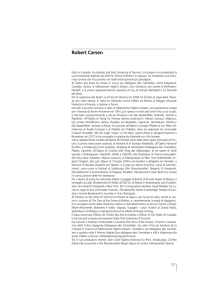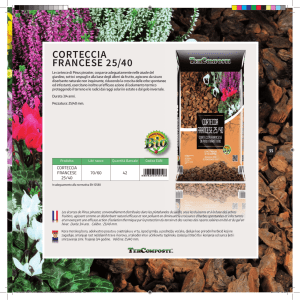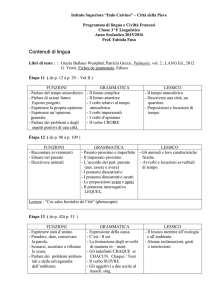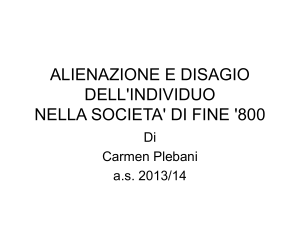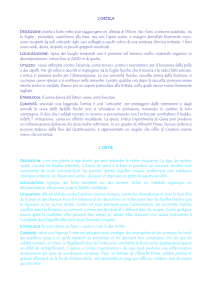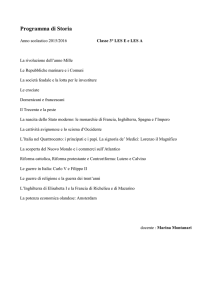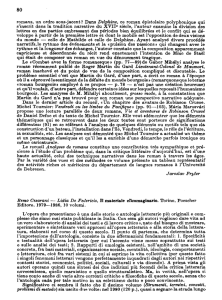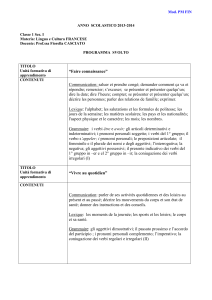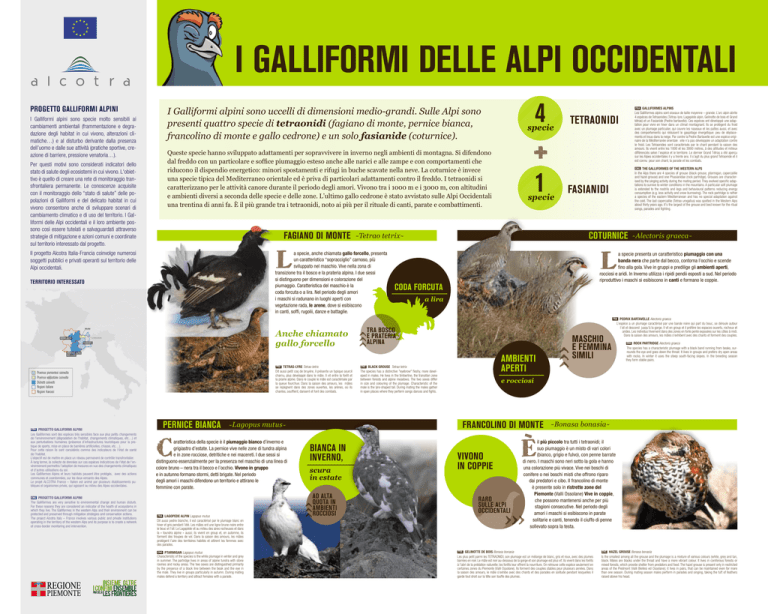
I galliformi delle alpi occidentali
PROGETTO GALLIFORMI ALPINI
I Galliformi alpini sono specie molto sensibili ai
cambiamenti ambientali (frammentazione e degradazione degli habitat in cui vivono, alterazioni climatiche…) e al disturbo derivante dalla presenza
dell’uomo e dalle sue attività (pratiche sportive, creazione di barriere, pressione venatoria…).
Per questi motivi sono considerati indicatori dello
stato di salute degli ecosistemi in cui vivono. L'obiettivo è quello di creare una rete di monitoraggio transfrontaliera permanente. Le conoscenze acquisite
con il monitoraggio dello “stato di salute” delle popolazioni di Galliformi e del delicato habitat in cui
vivono consentono anche di sviluppare scenari di
cambiamento climatico e di uso del territorio. I Galliformi delle Alpi occidentali e il loro ambiente possono così essere tutelati e salvaguardati attraverso
strategie di mitigazione e azioni comuni e coordinate
sul territorio interessato dal progetto.
4
+
1
I Galliformi alpini sono uccelli di dimensioni medio-grandi. Sulle Alpi sono
presenti quattro specie di tetraonidi (fagiano di monte, pernice bianca,
francolino di monte e gallo cedrone) e un solo fasianide (coturnice).
specie
Queste specie hanno sviluppato adattamenti per sopravvivere in inverno negli ambienti di montagna. Si difendono
dal freddo con un particolare e soffice piumaggio esteso anche alle narici e alle zampe e con comportamenti che
riducono il dispendio energetico: minori spostamenti e rifugi in buche scavate nella neve. La coturnice è invece
una specie tipica del Mediterraneo orientale ed è priva di particolari adattamenti contro il freddo. I tetraonidi si
caratterizzano per le attività canore durante il periodo degli amori. Vivono tra i 1000 m e i 3000 m, con altitudini
e ambienti diversi a seconda delle specie e delle zone. L’ultimo gallo cedrone è stato avvistato sulle Alpi Occidentali
una trentina di anni fa. È il più grande tra i tetraonidi, noto ai più per il rituale di canti, parate e combattimenti.
fagiano di montE
specie
tetraONIDI
COTURNICE
˜ Tetrao tetrix˜
a specie, anche chiamata gallo forcello, presenta
un caratteristico “sopracciglio” carnoso, più
sviluppato nel maschio. Vive nella zona di
transizione tra il bosco e la prateria alpina. I due sessi
si distinguono per dimensioni e colorazione del
piumaggio. Caratteristica del maschio è la
coda forcuta o a lira. Nel periodo degli amori
i maschi si radunano in luoghi aperti con
vegetazione rada, le arene, dove si esibiscono
in canti, soffi, rugolii, danze e battaglie.
TERRITORIO INTERESSATO
Eng The Galliformes of the Western Alps
In the Alps there are 4 species of grouse (black grouse, ptarmigan, capercaillie
and hazel grouse) and one Phasianidae (rock partridge). Grouses are characterised by the singing activity during the mating period. They evolved specific adaptations to survive to winter conditions in the mountains. A particular soft plumage
is extended to the nostrils and legs and behavioural patterns reducing energy
consumption (e.g. less activity and snow burrowing). The rock partridge is rather
a species of the eastern Mediterranean and has no special adaptation against
the cold. The last capercaillie (Tetrao urogallus) was spotted in the Western Alps
about thirty years ago. It's the largest of the grouse and best known for the ritual
songs, parades and fighting.
FASIANIDI
L
Il progetto Alcotra Italia-Francia coinvolge numerosi
soggetti pubblici e privati operanti sul territorio delle
Alpi occidentali.
fra GALLIFORMES ALPINS
Les Galliformes alpins sont oiseaux de taille moyenne – grande. L’arc alpin abrite
4 espèces de Tetraonides (Tétras-lyre, Lagopède alpin, Gelinotte de bois et Grand
tétras) et un Fasianide (Pedrix bartavelle). Ces espèces ont développé une adaptation pour vivre en hiver dans un climat montagnard. Ils se protègent du froid
avec un plumage particulier, qui couvre les naseaux et les pattes aussi, et avec
des comportements qui réduisent le gaspillage énergétique: peu de déplacements et trous dans la neige. Par contre la Pedrix Bartavelle est une espèce originaire de la Méditerranée orientale : elle n’a pas développée un adaptation contre
le froid. Les Tetraonides sont caractérisés par le chant pendant la saison des
amours. Ils vivent entre les 1000 et les 3000 mètres, à des altitudes et milieux
différenciés selon l’espèce et le territoire. Le dernier Grand Tétras a été aperçu
sur les Alpes occidentales il y a trente ans. Il s’agit du plus grand Tetraonide et il
est connu pour son chant, la parade et les combats.
˜ Alectoris graeca˜
L
a specie presenta un caratteristico piumaggio con una
banda nera che parte dal becco, contorna l’occhio e scende
fino alla gola. Vive in gruppi e predilige gli ambienti aperti,
rocciosi e aridi. In Inverno utilizza i ripidi pendii esposti a sud. Nel periodo
riproduttivo i maschi si esibiscono in canti e formano le coppie.
coda forcuta
a lira
PEDRIX BARTAVELLE Alectoris graeca
L’espèce a un plumage caractérisé par une bande noire qui part du bouc, se déroule autour
l’oïl et descend jusqu’à la gorge. Il vit en group et il préfère les espaces ouverts, rocheux et
arides. Les individus hivernent dans des zones en forte pente exposées sur les côtes à midi.
Dans la saison des amours, les mâles s'exhibent avec des chants et forment des couples.
fra
Valle d’Aosta
RHONE-ALPES
tra bosco
e prateria
alpina
Anche chiamato
gallo forcello
Finanziata con fondi esterni
PIEMONTE
PROVENCE ALPES
COTE AZUR
TETRAS-LYRE Tetrao tetrix
Dit aussi petit coq de bruyère, il présente un typique sourcil
charnu, plus développé dans le mâle. Il vit entre la forêt et
la prairie alpine. Dans le couple le mâle est caractérisée par
la queue fourchue. Dans la saison des amours, les mâles
se rejoignent dans des zones ouvertes, les arènes, où ils
chantes, soufflent, dansent et font des combats.
fra
Province piemontesi coinvolte
Province valdostane coinvolte
Distretti coinvolti
Regioni italiane
Regioni francesi
fra PROGETTO GALLIFORMI ALPINI
Les Galliformes sont des espèces très sensibles face aux plus petits changements
de l'environnement (dégradation de l’habitat, changements climatiques, etc…) et
aux perturbations humaines (présence d’infrastructures touristiques pour la pratique de sports, mise en place de barrières artificielles, chasse, etc…).
Pour cette raison ils sont considérés comme des indicateurs de l'état de santé
de l’habitat.
L’objectif est de mettre en place un réseau permanent de contrôle transfrontalier.
À long terme, la collecte de données sur ces espèces indicatrices de l'état de l'environnement permettra l’adoption de mesures en vue des changements climatiques
et d’autres utilisations du sol.
Les Galliformes Alpins et leurs habitats peuvent être protégés, avec des actions
communes et coordonnées, sur les deux versants des Alpes.
Le projet ALCOTRA Franco – Italien est animé par plusieurs établissements publiques et organismes privés, qui agissent au milieu des Alpes occidentales.
eng PROGETTO GALLIFORMI ALPINI
The Galliformes are very sensitive to environmental change and human disturb.
For these reasons they are considered an indicator of the health of ecosystems in
which they live. The Galliformes in the western Alps and their environment can be
protected and preserved through mitigation strategies and conservation actions.
The project Alcotra Italy – France involves various public and private institutions
operating in the territory of the western Alps and its purpose is to create a network
of cross-border monitoring and intervention.
PERNICE BIANCA
C
fra LAGOPEDE ALPIN Lagopus mutus
Dit aussi pedrix blanche, il est caractérisé par le plumage blanc en
hiver et gris pendant l’été. Les mâles ont une ligne brune-noire entre
le bouc et l’oïl. Le Lagopède vit au milieu des aires rocheuses et dans
la « toundra alpine » aussi; ils vivent en group et, en automne, ils
forment des troupes de vol. Dans la saison des amours, les mâles
protègent l’aire des territoires habités et attirent les femmes avec
des parades.
eng Ptarmigan Lagopus mutus
Characteristic of the species is the white plumage in winter and grey
in summer. The partridge lives in areas of alpine tundra with stone
ravines and rocky areas. The two sexes are distinguished primarily
by the presence of a black line between the beak and the eye in
the male. They live in groups particularly in autumn. During mating
males defend a territory and attract females with a parade.
bianca in
inverno,
scura
in estate
ad alta
quota in
ambienti
rocciosi
Rock partridge Alectoris graeca
The species has a characteristic plumage with a black band running from beaks, surrounds the eye and goes down the throat. It lives in groups and prefers dry open areas
with rocks. In winter it uses the steep south-facing slopes. In the breeding season
they form stable pairs.
eng
e rocciosi
FRANCOLINO DI MONTE
˜ Lagopus mutus˜
aratteristica della specie è il piumaggio bianco d’inverno e
grigiastro d’estate. La pernice vive nelle zone di tundra alpina
e in zone rocciose, detritiche e nei macereti. I due sessi si
distinguono essenzialmente per la presenza nel maschio di una linea di
colore bruno – nera tra il becco e l’occhio. Vivono in gruppo
e in autunno formano stormi, detti brigate. Nel periodo
degli amori i maschi difendono un territorio e attirano le
femmine con parate.
AMBIENTI
APERTI
Black grouse Tetrao tetrix
The species has a distinctive "eyebrow" fleshy, more developed in males. He lives in the timberline, the transition zone
between forests and alpine meadows. The two sexes differ
in size and colouring of the plumage. Characteristic of the
male is the lyre-shaped tail. During mating the males gather
in open places where they perform songs dances and fights.
eng
MASCHIO
E FEMMINA
SIMILI
vivono
in coppie
raro
sulle Alpi
occidentali
˜ Bonasa bonasia˜
È
il più piccolo tra tutti i tetraonidi; il
suo piumaggio è un misto di vari colori
(bianco, grigio e fulvo), con penne barrate
di nero. I maschi sono neri sotto la gola e hanno
una colorazione più vivace. Vive nei boschi di
conifere o nei boschi misti che offrono riparo
dai predatori e cibo. Il francolino di monte
è presente solo in ristrette zone del
Piemonte (Valli Ossolane) Vive in coppie,
che possono mantenersi anche per più
stagioni consecutive. Nel periodo degli
amori i maschi si esibiscono in parate
solitarie e canti, tenendo il ciuffo di penne
sollevato sopra la testa.
fra GELINOTTE DE BOIS Bonasa bonasia
Les plus petit parmi les TETRAONIDI, son plumage est un mélange de blanc, gris et roux, avec des plumes
barrées en noir. Le mâle est noir au-dessous de la gorge et son plumage est plus vif. Ils vivent dans les forêts
à l’abri de la prédation naturelle; les forêts leur offrent la nourriture. On retrouve cette espèce seulement en
certaines zones du Piemonte (Valli Ossolane). Ils forment des couples stables pour plusieurs années. Dans
la saison des amours, le mâle s'exhibe avec des chants et des parades en solitude pendant lesquelles il
garde tout droit sur la tête son touffe des plumes.
eng Hazel grouse Bonasa bonasia
Is the smallest among all the grouse and the plumage is a mixture of various colours (white, grey and tan,
black. Males are blacks under the throat and have a more vibrant colour. It lives in coniferous forests or
mixed forests, which provide shelter from predators and food. The hazel grouse is present only in restricted
areas of the Piedmont (Valli Biellesi ed Ossolane); it lives in pairs, that can be maintained even for more
than one season. During mating season males perform in parades and singing, taking the tuft of feathers
raised above his head.

